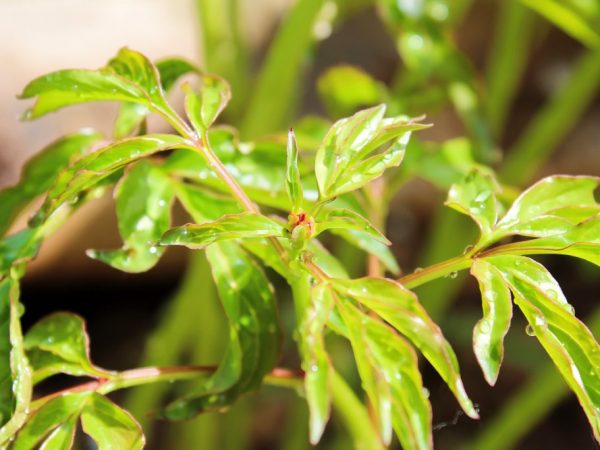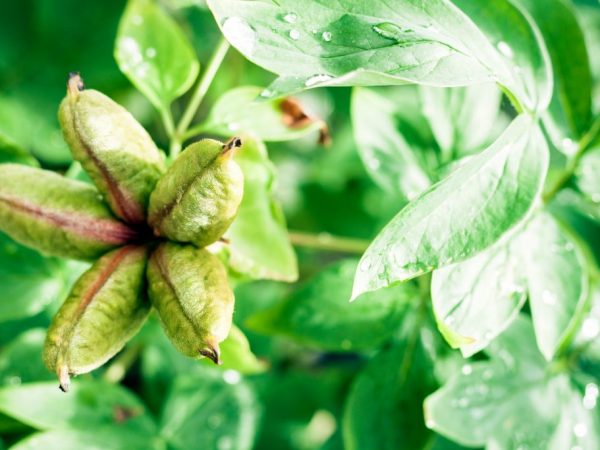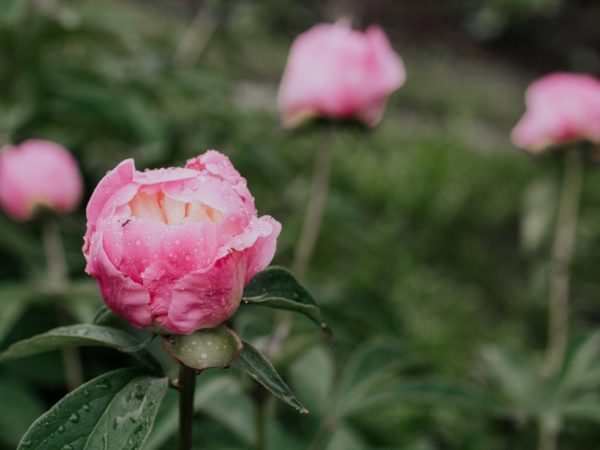Autumn peony transplant - the secrets of a successful procedure
If you love peonies and want to make your own peony garden, it is important to learn how to properly care for these flowers. Let's start creating your beautiful dream today. First, let's look at how to transplant peonies to a new place in the fall. If everything is done correctly, in the spring you will have 3-4 from one bush, and blooming! Great, isn't it?
- Why transplant peonies
- Excessive overgrowth
- Long stay in one bed
- Redevelopment
- When is it better to transplant - in autumn or spring
- Optimal timing
- By region
- Lunar calendar
- How to transplant correctly
- Seat selection
- Priming
- Transplant technology
- Follow-up care
- Watering
- Top dressing
- Loosening, hilling
- Pruning
- Wintering
- Summing up

Autumn peony transplant - the secrets of a successful procedure
Why transplant peonies
Peony breeders note the dislike of these flowers for transplants and recommend that it be carried out no earlier than 4-5 years after planting. And very carefully.
You will say that herbaceous peonies can not be transplanted for 20 years, and tree-like ones - generally 70? Yes, that's right, these rhizome flowers do just fine without transplanting, but only if they are comfortable in their place:
- there is enough nutrition in the soil;
- neighbors do not shade;
- the bush is well ventilated, not thickened;
- not disturbed by groundwater.
To determine if a peony feels good in its place, answer these questions:
- Does the flower bloom abundantly and regularly?
- Do the inflorescences correspond to the varietal size?
- Are all the buds blooming? No falling off?
- Do the flowers last long?
- Leaves are large, shiny, even saturated color?
- Are the stems strong?
- Growing at the same rate?
If you answered “no” to at least one question, it means that not everything is going well in the peony kingdom. Most likely, it's time to think about changing the place of residence of the plant.
Consider the main signs and causes of trouble.
Excessive overgrowth
Peony belongs to not very moody flowers. Two conditions that must be met strictly:
- Free air circulation around the bushes;
- Sunlight all day long. Only light partial shade at noon is permissible.
Therefore, peonies are not planted next to large plants, close to the walls of buildings.
This flower quickly grows green mass, its large leaves in an overgrown bush shade each other. Eventually:
- Flowering becomes less abundant, up to cessation.
- The leaves are getting smaller.
- Not all buds open.
- The growth of the stems slows down, they are bent.
- The bush becomes asymmetrical, loses its decorative effect.
- There is a high risk of "catching" a fungal disease - it is the thickened plantings that the pathogenic microflora loves so much!
These signs appear in flowers over 7-10 years old.
To prevent the deterioration of the quality of peonies from thickening and overgrowing, you need to regularly separate the bushes and plant them. The procedure is performed once every 6-8 years.
Long stay in one bed
Powerful peony bushes need a lot of nutrition.
As the plant grows, nutrients from the soil are consumed faster, their supply is replenished by the gardener when feeding.

Peonies take useful trace elements from the soil
After 10-12 years, the soil will be depleted, especially in terms of trace elements, and the peony will switch to starvation mode:
- The leaves will lose their shine, begin to fade.
- The buds can form, but the bush does not have enough strength for their further development, so most of them do not open.
Peonies have few pests, but there are enough diseases. Their pathogens accumulate in the soil, but they are safe for a strong plant. Over time, colonies of pathogens grow, and the peony's immunity decreases.
And the inevitable comes - illness, loss of decorativeness and the possible death of a peony. A transplant is the only salvation.
Redevelopment
It happens that the peony is doing well, it is beautiful and happy, it pleases with buds and carved healthy leaves, but ... It does not look at all in the current composition.
But in combination with roses (irises / asters / chrysanthemums), it will look more advantageous - and in this case, the transplant is justified.
When is it better to transplant - in autumn or spring
It is important that after transferring to another place the plants do not interrupt flowering. Peonies do not like transplants very much, and in response they stop bud formation during the entire adaptation period.
Dividing and transplanting during rest will be the least traumatic: in early spring or autumn.
If these operations are performed in the spring, there will be no flowering this year for sure - the bush will begin to spend energy on engraftment and will not have time to get stronger by the beginning of budding. There is one significant nuance: vegetative roots begin to grow at 3C, therefore, when digging out a bush, they are in an active stage, and when they are in the air for more than 5 minutes, they die. Spring transplantation of peonies is possible only by the transshipment method.
But in the fall, the peony has enough time for everything. Coolness and rains contribute to the development of young roots; by the winter cold, the cuttings will become so strong that they will be ready to continue flowering next spring, i.e. an autumn transplant is better in every way.
Optimal timing
For a transplant, you do not need to wait for autumn. This operation can be carried out after the end of flowering and ripening of the buds - already in August, when the suction roots begin to form in the peony. It is they who ensure the painless adaptation of the plant to a new place.
Main conditions:
- the air temperature during transplantation should not be higher than 20-22 ° С,
- a sufficient amount of moisture in the air and soil.
It is important to carry out the procedure 35-45 days before the onset of cold weather.
By region
Depending on the time of the onset of constant frosts, the maximum possible regional transplantation dates are also chosen:
- Ural, Siberia - mid-August;
- Middle lane, Moscow region - August-early September;
- South, Crimea, Kuban - end of September.
If you cannot carry out the transplant within the specified time frame, it is better to postpone it to the next year. Otherwise, the roots will not have time to form, the plant may not survive the winter or will be weakened and most likely to get sick.
Lunar calendar

The procedure is recommended to be carried out on the growing moon.
The lunar calendar prescribes operations related to the roots in the growing phase. It was during this period that the underground part of the plants (roots, tubers, rhizomes) are at rest and are not so stressed by mechanical damage.
For 2019, these are the following dates:
- August: 2-14, 31;
- September: 1-13, 29-30;
- October: 1-13, 29-31.
How to transplant correctly
To preserve the flowering of a peony after transplantation, it is important not only to choose the right timing of the operation, but also to carry it out in the least traumatic way for the plant. At the same time, taking into account the characteristics of the flower and providing optimal conditions for adaptation.
Seat selection
Peony is a light-loving subtropical plant, therefore it has special requirements for the planting site. It should be:
- Sunlit for at least 8-10 hours, possibly with light shading for 3-4 hours a day.
- Protected from the wind, but with free air circulation.
- Away from large plants and buildings.
- No close groundwater approach.
- On a hill where water will not accumulate after rains and melting snow.
Peony is good at any time: its carved leaves, beautiful bush shape are attractive. He will retain these advantages even if the landing site is not quite appropriate. However, it will not bloom in the shade and in a draft.
Priming
Peonies grow in any soil. But their beauty is most fully revealed on light loams or sandy loams with a Ph value ranging from 6.0 to 6.8. More acidic soils must be treated with dolomite flour or ash before planting.
The soil is prepared beforehand, at least 2-3 weeks in advance: from garden soil, sand, peat and humus in equal shares
For this:
- The soil is dug onto the bayonet of a shovel, carefully selecting the weeds.
- Organic matter is introduced - rotted compost, leaf humus. The introduction of manure or poultry droppings leads to the appearance of spots on the leaves and a decrease in the plant's immunity to fungal diseases.
- Dig holes 60x60 cm in size.
Transplant technology
If you plan to plant several bushes, place them at a distance from each other:
- undersized varieties - at least 70 cm;
- medium height - up to 110 cm;
- tree-like - 150-180 cm.
Drainage is laid on the bottom in each pit - broken brick, expanded clay, pebbles. The "heavier" and damper the soil, the higher this layer should be - up to 20 cm.
Then the prepared soil and fertilizers are poured:
- 200 g double superphosphate;
- 1 tbsp of ferrous sulfate (or bury 2 cans);
- 0.5 tbsp potassium sulfate.
The soil mixture in the pit is mixed, watered and left to shrink.

Peonies have a very vulnerable root system.
The root system of the peony is very delicate, vulnerable, so the transplant procedure must be performed with the least damage to the rhizome.
For this you need:
- Dig in a bush in a circle at a distance of 40 cm from the stems;
- Insert the forks into the dug groove and loosen the bush so that it can be easily removed from the ground;
- Carefully loosen adhering soil. Never shake or knock on a hard surface! If it is necessary to divide the bush, then the small roots can be washed under a gentle stream of water;
- Leave to dry for several hours;
- Remove all diseased, damaged and dry roots with a sharp knife;
- Shorten the shoots to 20 cm;
- Divide the rhizome (if this operation is needed) so that 4 buds remain on each division;
- Dip the roots of the plant in a fungicide solution, then soak in a root-forming solution;
- Sprinkle the cuts with crushed activated charcoal, potassium permanganate or garden pitch.
A cut is placed in a pit with a ready-made soil mixture so that the root collar is at a depth of 5-7 cm. Fill in the rest of the soil, compact and watered abundantly - at least 5 liters of water for each bush.
Note! Young buds must be covered with earth, otherwise they will dry out and die. But too much deepening will lead to decay and stop flowering. The optimal soil layer above the buds is 3-5 cm.
Why there may be no flowering after transplant
Plants separated in autumn take root well, but begin to bloom only for 2-3 years. If the cuttings have not bloomed for 3 years, then the planting material is divided very finely. You need to wait until the bush gains the required volume.
Correctly transplanted peonies without division are capable of blooming the next year. If this did not happen, then there may be several reasons:
- too acidic soil;
- planting depth of more than 7 cm or less than 5 cm (with a deep one - the kidneys will rot, with a shallow one - they will freeze);
- there is an excess of nitrogen fertilizers or organic matter in the soil. The bush spends energy on increasing the green mass, and not on flowering;
- lack of moisture during the laying of flower buds;
- leaves and stems are cut immediately after flowering. They did not participate in the process of photosynthesis and did not transfer the necessary energy to the roots;
- the peony is damaged by diseases or pests.
Follow-up care
Post-transplant care should be gentle:
- watering only after the top layer has dried (excess moisture can cause rotting of an unrooted plant);
- regular surface loosening of the soil to improve aeration of the roots;
- spraying with adaptogens;
- termination of feeding.
Let's take a closer look at each of these operations.
Watering
The peculiarity of the procedure is that there are no suction roots at the base of the bush, they are located along the perimeter. In order for all the moisture to benefit the plant, a shallow groove is dug around the periphery of the root circle. And that's where the water is poured! When watering under the base of the bush, there is a risk of stem rot.
Peony is a "water bread"; for normal development and flowering, it needs abundant, but rare watering. The volume of each is 2-3 buckets per bush.
Watering is especially important for a transplanted flower at the end of August, when adventitious roots are actively developing.
But with all the love for water, a peony is better to under-drink than to pour it over. In the case of constantly "wet heels", the bush will start to rot and lose immunity to fungal diseases. Therefore, moisturizing the rhizome through watering holes is the safest.
Top dressing

Young plants don't need fertilizer
Transplanted peonies do not feed for the first 2-3 years. The plant has enough food that is laid in the planting hole.
At this time, foliar dressing is permissible 1-2 times per season with growth regulators and humates.
Starting from the 3rd year, feeding is carried out according to the standard scheme - 4 times a year, at the rate of 30-35 g of fertilizer (matchbox with a "slide") per bush:
- In the spring, during the period of active formation of leaves and stems - a full complex fat with a predominance of nitrogen. The most effective top dressing is through melted snow. Granular fertilizers are scattered around the bush. Together with melt water, they will quickly get to the awakening roots.
- During the budding period - complex fat with a predominance of potassium.
- During flowering - potassium-phosphorus mixtures, with an increased proportion of potassium.
- After flowering - phosphorus-potassium, with an excess of the proportion of phosphorus.
It is important to completely eliminate humates and nitrogen after July 15-20. And, of course, all fertilizing is carried out only after watering!
Loosening, hilling
In addition to basic procedures - watering and fertilizing - it is important to regularly aerate the soil.
Such actions saturate the soil with air and contribute to the active development of the suction roots.
However, loosening should be carried out to a depth of no more than 5 cm at the base of the bush, so as not to damage the root system. At the periphery of the root circle, a depth of 15 cm is permissible.
It is especially important to loosen after watering and rains.
As soon as the peony gets stronger after transplanting, you can huddle the bush - this contributes to the formation of additional roots.
Pruning
The peony does not need to be shaped - its natural form is perfect! If the symmetry of the bush is broken, it means that the place for the plant was chosen incorrectly.
A flowering peony needs pruning to extend its flowering period or to allow larger flowers to form.
Remember the rule:
- if you want to see large flowers, then remove the side buds when they become the size of a pea;
- if you prefer to admire a lush bush, then leave all the buds, but the flowers will not be very large.
Faded flowers should be removed immediately, cutting off to the first well-developed leaf with a hemp of no more than 2-3 mm.
This is especially important in rainy weather, as falling petals on leaves can cause gray rot. And it looks so untidy.
Wintering
The entire above-ground part of the peonies must be cut off, but this must be done only when the onset of constant cold weather. Until this time, the leaves, participating in photosynthesis, supply the roots with nutrients. Pruning early will greatly weaken the plant.
After pruning, you need to carefully examine the bases of the shoots - whether the growth buds are bare. In order to protect them, peonies are covered with fertile soil to a height of 7-10 cm. Peonies tolerate cold weather well. Usually, only plants that are transplanted shortly before the onset of frost need shelter.
In this case, they are covered with peat or leafy humus up to 15-20 cm thick. Peonies most often die not from frost, but from podoprevanie. Therefore, straw or leaves cannot be used as shelter.
Adult rooted peonies do not cover for the winter.
Summing up
Peonies can be transplanted from 4-5 years of age.
The operation is necessary if:
- the bush has grown;
- the flowers become smaller, they become smaller;
- the plant has stopped growing.
The peony is transplanted in the fall, 35-45 days (in extreme cases, a month) before the onset of constant cold weather.
In the process of transplanting, the bush can be divided. Each division should have at least 3-4 growth buds.
When planting, the root collar is deepened by 5-7 cm.
The transplanted plant is watered into a circular groove at the border of the root circle, but not fed.
Here, perhaps, are all the secrets. Nothing complicated, right? But how much joy will be brought to you by the children of your pets, who have taken root in a new place. Beauty will settle at the summer cottage. And you did it!

